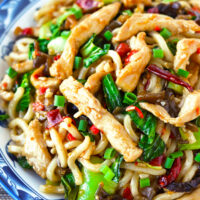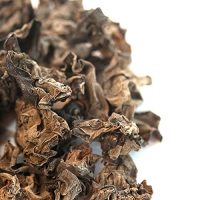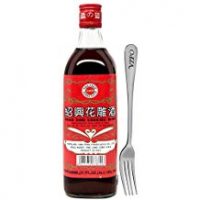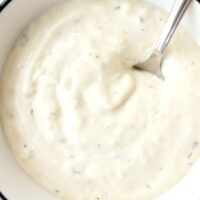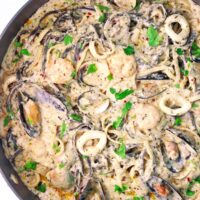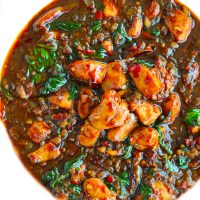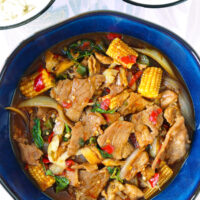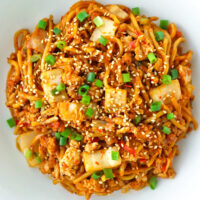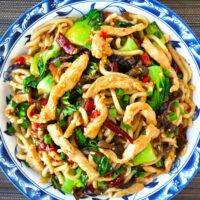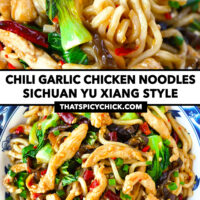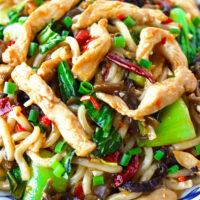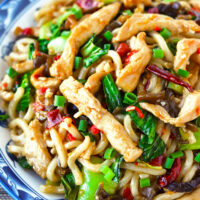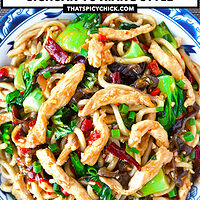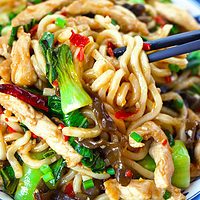Chili Garlic Chicken Noodles (Sichuan Yu Xiang Style)
This post contains affiliate links.
This Chili Garlic Chicken Noodles dish is an easy Sichuan “yu xiang” style noodles stir-fry that’s full of the BEST spicy, savory, and tangy notes with a hint of sweetness! Tender chicken strips, chewy and slippery noodles, cloud ear mushrooms, bok choy, and plenty of garlic and chilies get tossed in a mouthwatering bold flavored sauce!
If you love the hot and sour, garlicky flavors in Sichuan “yu xiang” dishes like Yu Xiang Chicken and Yu Xiang Eggplant, you are going to LOVE this Chili Garlic Chicken Noodles dish!
We have silky tender chicken strips, Lao Gan Ma’s highly addictive pickled chilies sauce, chewy cloud ear mushrooms, slurp-i-licious Shanghai noodles, and tender crisp bok choy in the BEST garlicky, spicy, slightly tangy and sweet sauce!
This flavor-packed, easy noodles stir-fry is ready in just about 35 minutes and perfect for any night of the week.
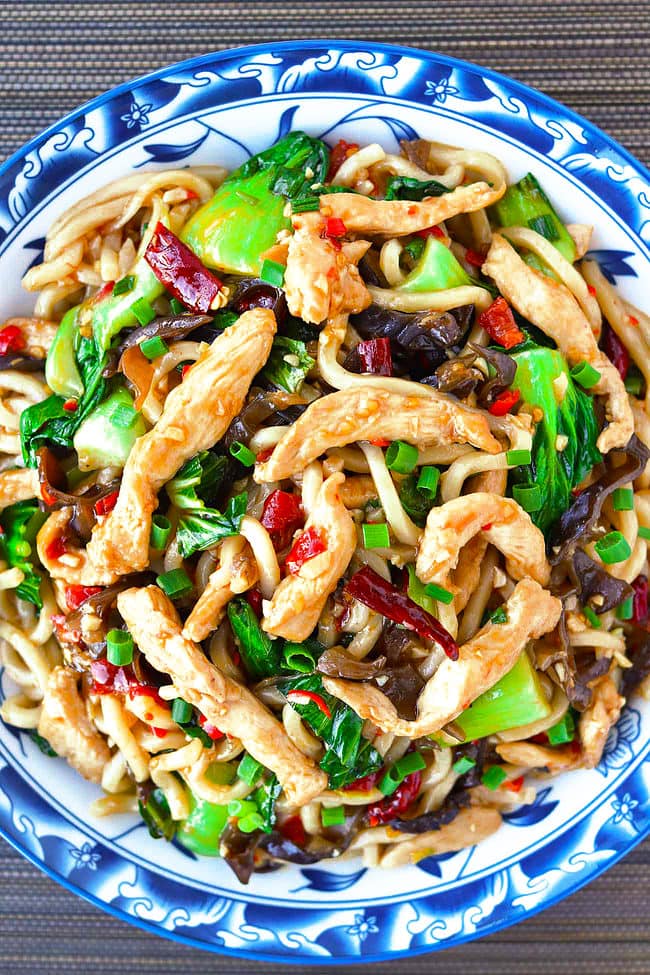
What Are Yu Xiang Dishes?
Directly translated, “yu xiang” means fish-fragrant. However, there are zero fish ingredients and no hint of any fishy smell in these chili garlic chicken noodles. In the Sichuan region, several dishes use the same combination of ingredients and style of cooking for a traditional fish dish with a hot garlic sauce that has the same spicy, sweet and sour flavors. Hence, “yu xiang” dishes are simply dishes with a hot and spicy garlic sauce.
Why This Recipe Works
- Quick and easy to make. The prep work takes longer than stir-frying the noodles. The actual cooking part is a breeze and the dish is ready in about 10 minutes!
- EXPLODING with flavor! The savory, spicy, garlicky and sour flavors with just the right amount of sweetness will tantalize your tastebuds!
- Best textures. The tender chicken strips are complimented by the chewy and soft texture of the cloud ear mushrooms, tender crisp Asian greens, and silky and slippery noodles.
- Lao Gan Ma Pickled Chilies sauce is addictive. It replaces the traditional Sichuan pickled chilies (which are difficult to source outside of China) used for in “yu xiang” dishes to deliver the signature hot and sour flavors.
- Customizable. You can use your favorite type of protein (chicken, beef, pork, shrimp, plant-based meat or tofu) and Asian greens or Western greens in a pinch.
Ingredient Notes and Substitutes
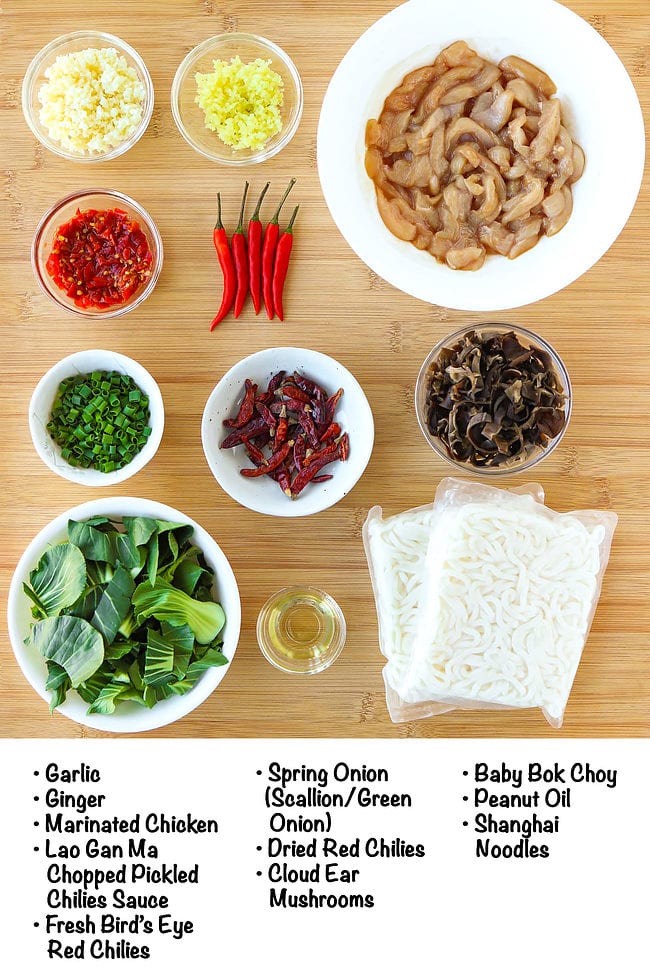
- Marinated Chicken: I used boneless and skinless chicken breasts. They’re easier to slice into thin slivers than chicken thighs due to being more firm. Though, boneless and skinless chicken thighs can be used if you prefer. The chicken is marinated with kosher salt, potato starch, low sodium light soy sauce, Shao Xing rice wine, and sesame oil. (See ‘Variations’ section below for more protein options.)
- Aromatics: The Chinese holy trinity – spring onion (scallion/green onion), ginger and garlic.
- Fresh Bird’s Eye Red Chilies: Or use any other small hot red chilies that are easily available to you. Use less or omit them for a milder dish.
- Pickled Chilies Sauce: Pickled fresh er jing tiao chilies (pao la jiao – 泡辣椒) are traditionally used in “yu xiang” dishes in the Sichuan region. However, I find Lao Gan Ma Pickled Chilies sauce is an excellent substitute. It has a similar hot and tangy flavor profile and is super tasty! Try finding a jar at an Asian or Chinese supermarket, or purchase one online. You can substitute with sambal oelek or chopped Mexican or Thai pickled red chilies for a similar flavor.
- Dried Red Chilies: I’ve used Chinese Xiao Mi La dried red chilies here, which are very hot. Feel free to use any medium to hot Chinese or Thai dried red chilies. Note that Thai Bird’s Eye dried red chilies are incredibly hot and hotter than most Chinese dried red chilies. Be sure to use less if using them. Omit the dried chilies completely to make the noodles milder.
- Baby Bok Choy: Or use any other Asian greens you like. Choy sum or Chinese/Napa cabbage would work great. You could also sub in broccoli or baby spinach if you don’t have any Asian greens on hand.
- Shanghai Noodles: These are thick wheat-based Chinese white noodles. They have a lovely bouncy and chewy texture. You can find fresh Shanghai noodles in the fridge section of Asian and Chinese supermarkets. Alternatively, use the vacuum sealed packs of pre-cooked noodles like I have here. A great substitute would be udon noodles as they have a similar chewy texture. Avoid using dried udon noodles if you can help it as they won’t have the same bouncy texture.
- Dried Cloud Ear or Wood Ear Mushrooms: These mushrooms are also known as Chinese black fungus. Wood ear mushrooms are typically used in “yu xiang” dishes. I used dried cloud ear mushrooms here as they’re both similar in texture, appearance, and taste and are readily available where I live. If you’re using dried mushrooms like I have, you’ll need to soak them in a bowl of water to rehydrate before slicing and briefly blanching. For fresh mushrooms, you only need to rinse and slice them before blanching.

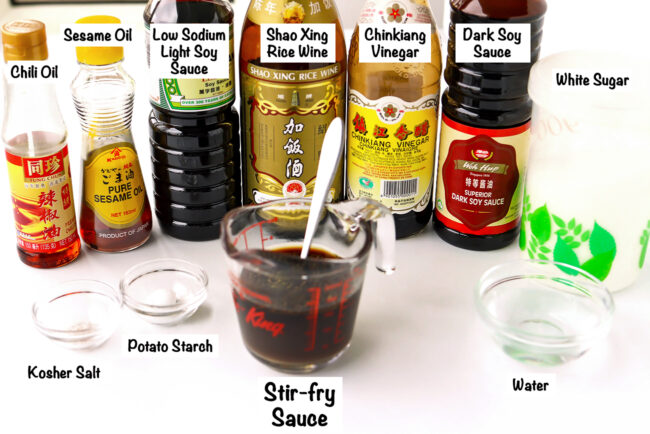
- Kosher Salt: Use half the amount if using iodized table salt as it is saltier than kosher salt.
- Potato Starch: Or use corn starch to act as the thickening agent in the sauce (and chicken marinade).
- White Sugar: Adjust the amount to taste if using less chilies. You may not need as much to balance out the heat.
- Low Sodium Light Soy Sauce: Low sodium so that we can control the salt levels better.
- Shao Xing Rice Wine: A fragrant Chinese cooking wine with a floral aroma. Find it in an Asian or Chinese supermarket or purchase a bottle online. Or substitute with dry sherry.
- Chinkiang Vinegar: This is a Chinese black vinegar can be found in Chinese and Asian supermarkets as well as purchased online. Substitute with half distilled white vinegar and half balsamic vinegar to yield a similar flavor.
- Dark Soy Sauce: This is primarily used for color and is less salty than light soy sauce. Use low sodium light soy sauce instead if you don’t have it on hand.
- Pure Chili Oil (optional): A Chinese chili oil without flakes or seeds to add extra heat. Omit it if less heat is desired.
Full ingredient list and amounts are in the recipe card below.
How to Make Chili Garlic Chicken Noodles
1. Prepare the noodles. If using vacuum sealed packs of pre-cooked noodles, all you need to do is place the noodle cakes in a pot of boiling water and use tongs to gently shake them until the strands separate from one another and are tender. This process is quick and only takes a minute before you need to drain. Then run cold water over the noodles to stop them from sticking and halt the cooking process.
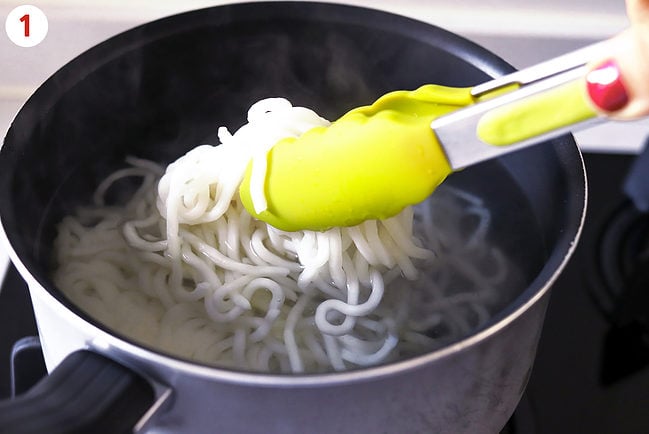
2. Cook the chicken. Stir-fry the marinated chicken in a large wok over high heat until 80% cooked. Transfer to a clean bowl and set aside.
3. Sauté the pickled chilies sauce. Just briefly until you can smell it.
4. Stir-fry the spring onion white and light green parts, ginger and garlic.
5. Stir-fry the fresh and dried red chilies until fragrant.
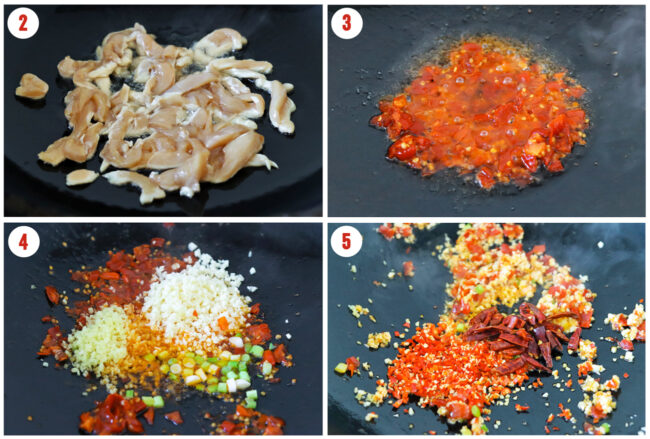
6. Add the mushrooms and bok choy. Stir-fry until the greens are just starting to soften.
7. Add the noodles, chicken and sauce. Crank the heat up to high and add the noodles and chicken. Pour the sauce over everything and toss and mix continuously until the sauce thickens and coats everything well.
8. Toss through spring onion dark green parts. Switch off the heat.
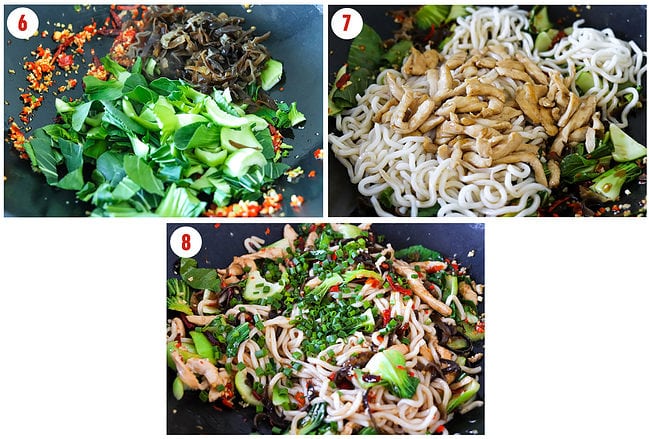
Serve! Transfer to a serving plate and sprinkle with chopped spring onion dark green parts. Serve immediately and enjoy!

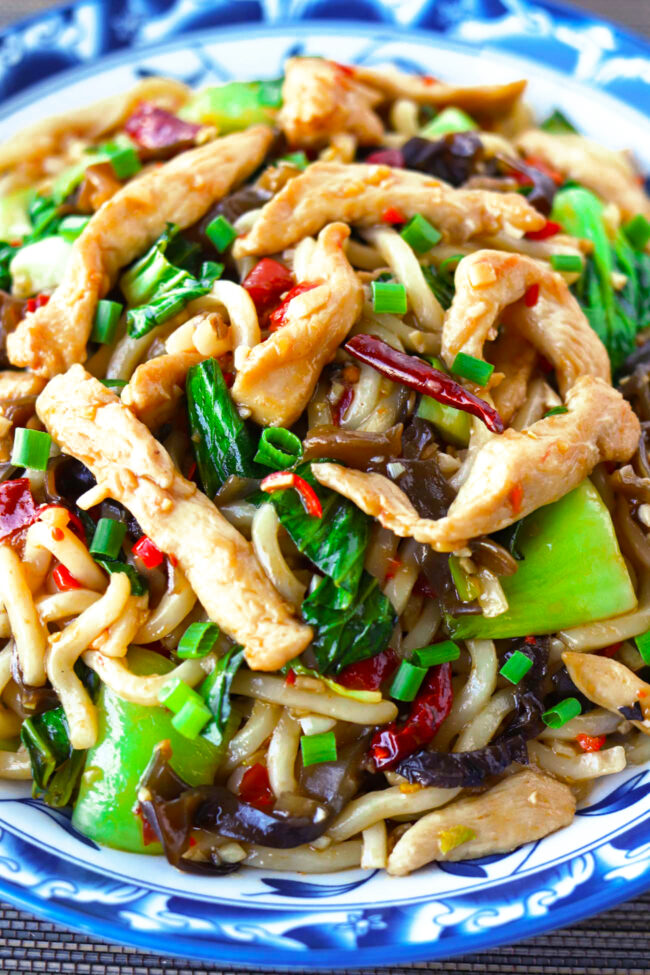
Full detailed instructions are in the recipe card below.
Cook’s Tips
- Freeze the chicken before slicing. Twenty minutes in the freezer will make it firmer and easier to slice into thin strips.
- Wet your knife to prevent the meat from sticking to it while slicing.
- Use less sauce from the pickled chilies sauce jar and more of the chopped chilies. The liquid in the jar is quite salty and sour. Try to mostly use the chopped pickled chilies, though a little sauce will not do any damage.
- Adjust spice level to taste. Use less fresh and dried chilies and omit the chili oil in stir-fry sauce for a milder noodles dish. Although you can use less of the pickled chilies sauce too, you may need to add more kosher salt to taste to compensate.
- Use a large wok or heavy bottomed frying pan. To avoid having mushy noodles, use a large enough wok or deep heavy bottomed frying pan. Make sure that the cooking vessel is not overcrowded and turn the heat up at the end so that the sauce thickens quickly and clings to the noodles.
FAQs
They’re made from wheat, water, salt, and also egg white if they are fresh noodles. There’s a thin and thick variety, and the thick type are round with a chewy texture similar to that of udon noodles.
They are both great for stir-fries and the only difference is that baby bok choy is sweeter and more tender than regular bok choy.
3-4 days. Store leftovers in a sealed airtight container in the fridge. Reheat in the microwave on high for 1-2 minutes, stirring halfway in between, until hot throughout.
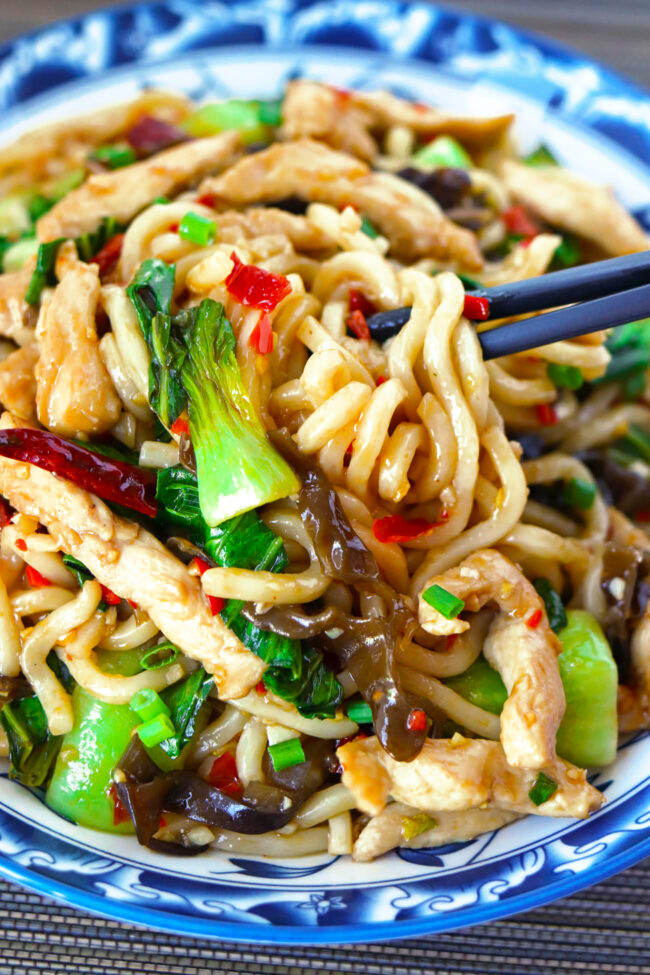
Variations
- Use a different protein. Pork fillet (tenderloin) or beef flank or skirt steak can be used instead of chicken if you prefer. Shrimp/prawns would work well for pescatarians and crispy pan-fried tofu cubes for vegetarians.
- Use different veggies. If you don’t have any Asian greens on hand, use broccoli or baby spinach instead. You can add snow peas, sliced onion, carrots, bamboo shoots or even celery too. Swap the dried cloud or wood ears for sliced Asian brown mushrooms such as shiitakes or any other mushrooms you like. Stir-fry the mushrooms after sautéing the pickled chilies sauce. You might need to add more oil if the wok looks dry before adding the rest of the aromatics.
- Make it vegetarian. Use pan-fried tofu cubes or tempeh, but omit the chicken marinade ingredients if doing so and season with salt and pepper. A shredded plant-based meat substitute can also be subbed in. Marinate and cook it separately first like you would the chicken.
- Make it gluten-free. Use a gluten-free light soy sauce (low sodium if possible), dry sherry instead of the Shao Xing rice wine, and distilled white vinegar in place of the Chinkiang vinegar. Also, use a gluten-free noodles or noodle-type pasta such as linguine, spaghetti or bucatini.
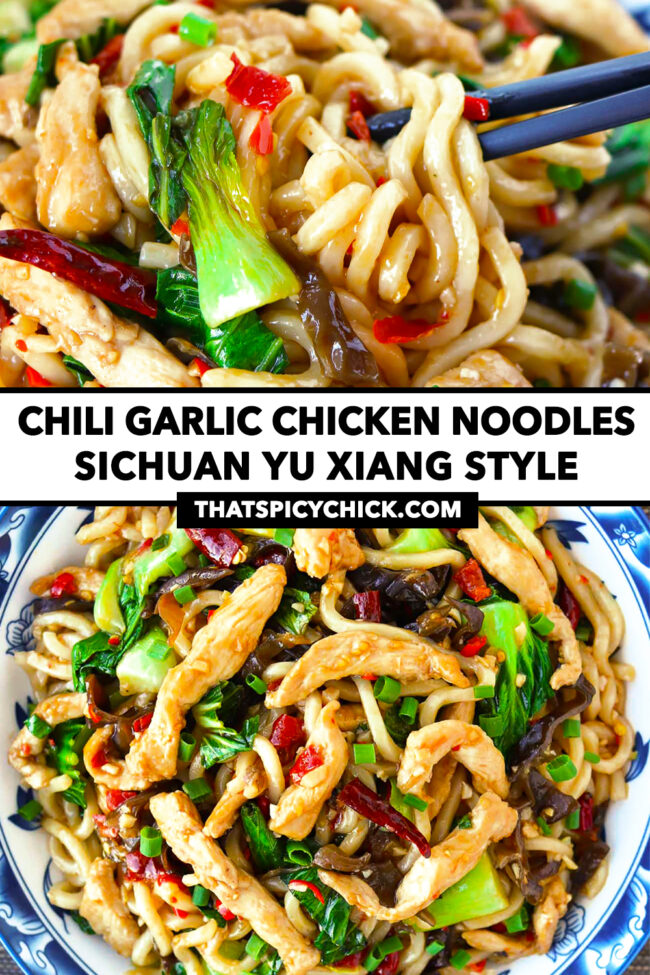
More Sichuan “Yu Xiang” Style Dishes
- Yu Xiang Chicken
- Yu Xiang Qie Zi (Fish-fragrant Eggplant)
- Tofu with Hot Garlic Sauce
- Sichuan Chili Garlic Chicken Fried Rice
More Sichuan Stir-Fries
- Sichuan Garlic Chicken Stir-fry
- Chicken in Vinegar Sauce (Sichuan Cu Liu Ji)
- Authentic Kung Pao Chicken
- Kung Pao Tofu Puffs
- Sichuan Dry-Braised Shrimp (Gan Shao Xia)
- Or browse the entire Sichuan recipes collection.
MADE THIS RECIPE? If you make this recipe, leave a comment below and let me know how you liked it! Take a photo and tag it with @thatspicychick on Instagram and hashtag it #thatspicychick and I’ll be sure to share your masterpiece!
STAY CONNECTED! You can also follow me on Pinterest, Facebook or Instagram. Sign up for my email list to get my latest recipe in your inbox weekly!
PrintChili Garlic Chicken Noodles (Sichuan Yu Xiang Style)
Tender chicken strips, chewy and slippery noodles, cloud ear mushrooms, bok choy, and plenty of garlic and chilies get tossed in a mouthwatering sauce in this Sichuan “yu xiang” style Chili Garlic Chicken Noodles!
- Prep Time: 25
- Cook Time: 10
- Total Time: 35 minutes
- Yield: 4 1x
- Category: Dinner
- Method: Stir-fry
- Cuisine: Sichuan
Ingredients
For the Chicken Marinade:
- 200 grams / 7 ounces Chicken Breast, boneless, skinless – cleaned and pat-dried, sliced into thin slivers
- ⅛ TSP Kosher Salt (use half the amount is using iodized table salt)
- ¾ TSP Potato Starch (or corn starch)
- 1 TSP Shao Xing Rice Wine
- ½ TBLS Low Sodium Light Soy Sauce
- ¼ TSP Sesame Oil
For the Sauce:
- ⅛ TSP Kosher Salt
- 1 TSP Potato Starch
- 1 TBLS White Sugar
- 1 TBLS Low Sodium Light Soy Sauce
- 2 TBLS Shao Xing Rice Wine
- 1 TBLS Chinkiang Vinegar (Chinese black vinegar)
- ½ TSP Dark Soy Sauce
- 1 TSP Pure Chili Oil (optional – without flakes/seeds)
- 1 TSP Sesame Oil
- ¼ cup + 2 TBLS Water
For the Yu Xiang Chicken Stir-fry:
- 10 grams / ¼ cup Dried Cloud Ear Mushrooms (or wood ear mushrooms – note 1)
- 1 Spring Onion (Scallion/Green Onion) – chopped, white and light green parts separated from dark green parts
- 2 TBLS minced Ginger
- 6 Garlic cloves – minced
- 1 – 5 fresh Red Chilies (optional – Thai Bird’s Eye or any other small hot red chilies, note 2), to taste – chopped
- 1 cup sliced Baby Bok Choy (or other Asian greens such as choy sum, Chinese/Napa cabbage, etc.)
- 2 – 6 Dried Red Chilies (note 3), to taste – snipped into ½-inch pieces
- 400 grams / 14 ounces Shanghai Noodles (or udon noodles, I used vacuum sealed packs – note 4)
- 3 TBLS Peanut Oil (or any neutral oil with a high smoke point)
- 3 TBLS Lao Gan Ma Pickled Chilies Sauce (note 5)
Instructions
Prep:
- Prepare the dried mushrooms: Place the dried cloud ear mushrooms in a bowl and fill with water. Soak for 20 minutes until rehydrated and tender. Drain into a strainer and rinse thoroughly. Pat-dry, then slice into thin strips. Make sure to slice off and discard the tough end tip. Bring a pot of water to a boil and add the sliced mushrooms. Blanche for 2 minutes, then drain into a strainer and run cold water on top to halt the cooking process. Set aside.
- Marinate the chicken: Slice the chicken breast into thin slivers. Add to a bowl, followed by the kosher salt, potato starch, Shao Xing rice wine, low sodium light soy sauce and sesame oil. Mix well to combine and set aside.
- Make the sauce: In a small bowl or measuring cup (for easier pouring), mix together the kosher salt, potato starch, white sugar, low sodium light soy sauce, Shao Xing rice wine, Chinkiang vinegar, dark soy sauce, pure chili oil (if using), sesame oil and water until thoroughly combined.
- Prepare the fresh and dry ingredients: Chop the spring onion, ginger, garlic, fresh red chilies and choy sum as indicated in the ‘ingredients’ section. Snip the dried red chilies into ½-inch pieces. (Tip: Shake out and discard some or all of the seeds from the dried chilies for a milder dish.)
For the Chili Garlic Chicken Noodles:
- Prepare the noodles: Bring a pot of water to a boil. Lower the heat to medium-low and add the noodle cakes into the pot. Use tongs to grab onto the cake and shake gently until the strands have separated and are tender – about 1 minute. Drain into a colander and run cold water on top to prevent sticking and halt the cooking process.
- Cook the chicken: Heat 3 tablespoons of peanut oil in a large wok over high heat. Once hot, add the marinated chicken slivers and immediately spread out the pieces in the wok. Stir-fry for 40 seconds, until 80% cooked. Transfer to a fine mesh strainer held above the wok and allow the excess oil to drip back in. Place the strainer on top of a clean bowl.
- Stir-fry the aromatics: Heat the oil in the wok over low heat. Add the pickled chilies and sauté for 20 seconds. Turn the heat back up to medium and add the spring onion white and light green parts, ginger and garlic. Stir-fry for 30 seconds until fragrant.
- Stir-fry the chilies: Add the fresh and dried red chilies and stir-fry for 30 seconds to combine.
- Add the veggies: Add the sliced mushrooms and bok choy. Stir-fry for 20 seconds or until the leafy parts of the greens are just starting to soften.
- Add the noodles, chicken and sauce: Turn the heat back up to high and add the noodles and chicken (and the juices in the bowl). Give the sauce a quick stir with a spoon to loosen up the potato starch that will have settled at the bottom. Pour it over everything and stir-fry continuously for 1 minute, until the sauce thickens and coats everything well.
- Toss through spring onion: Toss through most of the spring onion dark green parts (reserve a few pieces for garnish) and switch off the heat.
- To Serve: Transfer to a serving plate or divide evenly into bowls. Garnish with the reserved spring onion dark green parts and serve immediately.
Notes
- Dried Cloud Ear and Wood Ear Mushrooms. These are also known as Chinese black fungus. Wood ear mushrooms are typically used in “yu xiang” dishes. I used dried cloud ear mushrooms here as they’re both similar in texture, appearance, and taste and are easily available where I live. If you’re using dried mushrooms like I have, you’ll need to soak them in a bowl of water to rehydrate before slicing and briefly blanching. For fresh mushrooms, you only need to rinse and slice them before blanching.
- Fresh Red Chilies. Adjust the quantity to taste for less or more heat. Omit completely for a milder noodles dish.
- Dried Red Chilies. I’ve used Chinese Xiao Mi La dried red chilies here, which are very hot. Feel free to use any medium to hot Chinese or Thai dried red chilies. Note that Thai Bird’s Eye dried red chilies are incredibly hot and hotter than most Chinese dried red chilies. Be sure to use less if using them. Omit the dried chilies completely to make the noodles milder.
- Shanghai Noodles. These are thick wheat-based Chinese white noodles. They have a lovely bouncy and chewy texture. You can find fresh Shanghai noodles in the fridge section of Asian and Chinese supermarkets. Alternatively, use the vacuum sealed packs of pre-cooked noodles like I have here. A great substitute would be udon noodles as they have a similar chewy texture. Frozen or vacuum sealed packs are preferred over dry udon noodles as the dry noodles do not have the same bouncy texture.
- Lao Gan Ma Pickled Chilies Sauce. Pickled fresh er jing tiao chilies (pao la jiao – 泡辣椒) are traditionally used in “yu xiang” dishes in the Sichuan region. However, I find Lao Gan Ma Pickled Chilies sauce is an excellent substitute. It has a similar hot and tangy flavor profile and is super tasty! Try finding a jar at an Asian or Chinese supermarket, or purchase one online. You can substitute with sambal oelek or chopped Mexican or Thai pickled red chilies for a similar flavor.
- Leftovers and storing. Store leftovers in a sealed airtight container in the fridge for 3-4 days. Reheat in the microwave on high for 1-2 minutes, stirring halfway in between, until hot throughout.
- See ‘Variations’ section in the post above if you’d like to customize these noodles.
Nutrition
- Serving Size: 1 bowl
- Calories: 476
- Sugar: 20.2g
- Sodium: 487.6mg
- Fat: 16.5g
- Saturated Fat: 2.6g
- Unsaturated Fat: 11.8g
- Trans Fat: 0g
- Carbohydrates: 66g
- Fiber: 11.5g
- Protein: 21.7g
- Cholesterol: 36.5mg
This post may contain affiliate links. We are a part of the Amazon Services LLC Associates Program, an affiliate advertising program designed to provide a means for us to earn a small commission (at no extra cost to you) by linking to Amazon.com and affiliated sites. The nutritional information provided is approximate and can vary based on several factors. It should only be used as a general guideline. For more information, please see our Disclosure.


